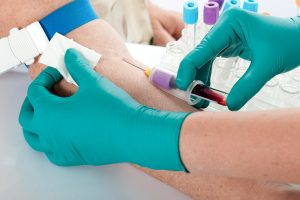Published on March 18, 2022
What is the difference between serum magnesium, red blood cell (RBC) magnesium, whole blood magnesium, and ionized magnesium, and what do they say about your magnesium status?
Key Points
- Serum magnesium is the most widely used measurement for magnesium status (often used by doctors’ offices), however, it has been recognized as unreliable for diagnosing most cases of magnesium deficiency, especially chronic or subclinical deficiency; while low serum magnesium is likely a good indicator of magnesium deficiency, serum magnesium within the accepted range does not indicate sufficient magnesium status throughout the body
- Whole blood magnesium includes the measure of magnesium in all types of blood cells (red blood cells, white blood cells, etc.) as well as the serum, which is a better indicator of magnesium status in the body and tissues than either the serum magnesium or RBC magnesium alone
- Symptom tracking done in combination with tracking magnesium intake and magnesium blood testing (such as whole blood magnesium testing offered through GrassrootsHealth) is the most comprehensive way to make sure you are getting enough magnesium, by moving your own personal research into practice!

Up to 60% of the US population is estimated to be deficient in magnesium. Deficient magnesium levels can be due to insufficient magnesium in the diet, as well as problems with kidney function, alcoholism, and the use of diuretics and proton pump inhibitors. The effects of low magnesium can include everything from fatigue and loss of appetite, to tremors and muscle cramps. Severe deficiency can cause cardiac arrhythmias, confusion, and seizures, while chronic subclinical magnesium deficiency can lead to general feelings of un-wellness and contribute to the development of many different diseases.
Where is Magnesium Stored in the Body?
The body needs between 3 and 5 mg of magnesium per kg of body weight, and its balance is highly regulated by intestinal absorption and excretion through the urinary tract (or intestines when intake is too much too quickly). The distribution of magnesium within the body can be broken down to about
- 50–60% in the bones
- 20% in skeletal muscles
- 19% in other soft tissues
- less than 1% in the extracellular fluid
Magnesium status within the body is regulated through gastrointestinal absorption, renal excretion, and exchange from magnesium stores in the bones. When magnesium intake is low, the body increases the percent of magnesium absorbed from the diet, decreases the amount excreted through the urine, and pulls magnesium from the bones to make it more available to other tissues throughout the body.
What Blood Tests Are Available to Measure Magnesium Status?
Several different tests exist for magnesium, some of which are more accurate than others.
Serum Magnesium
Serum is the clear, liquid part of blood, which does not include the red and white blood cells, platelets, and clotting proteins found in whole blood. While serum magnesium is the most widely used measurement for magnesium status (often used in doctors’ and medical offices), it has been recognized as unreliable for diagnosing most cases of magnesium deficiency, especially chronic or subclinical deficiency. Many studies have found a correlation between low magnesium intake and increased risk of disease, however, this relationship often does not correlate with serum magnesium levels.
The “normal” range of serum magnesium has been defined as 0.7 to 1 mmol/L. As explained above, less than 1% of total body magnesium is found in the serum. Also, due to the tight control of serum magnesium levels, levels of magnesium in the serum stop increasing in response to supplementation before truly sufficient levels of magnesium are reached throughout the body. This means that, while low serum magnesium is likely a good indicator of magnesium deficiency, serum magnesium within the accepted range does not indicate sufficient magnesium status throughout the body.
Red Blood Cell (RBC) and Whole Blood Magnesium
Red blood cell (RBC) magnesium measures the amount of magnesium in the red blood cells alone. While this is a better indicator of magnesium status than the serum magnesium measurement (it is more reflective of magnesium status within tissues), it is still not as accurate as the whole blood magnesium measurement. The whole blood magnesium includes the measure of magnesium in all types of blood cells (red blood cells, white blood cells, etc.) as well as the serum, which is a better indicator of magnesium status in the body and tissues than either the serum magnesium or RBC magnesium alone.
The dried blood spot magnesium test offered by GrassrootsHealth measures the whole blood magnesium, with the option to add other essential and toxic elements (copper, selenium, zinc, mercury, cadmium and lead). The reference range of the whole blood magnesium test is 29-51 mg/L, which is the range of the average population the lab serves, and does not necessarily indicate the optimal range for health. Aiming for the higher end of this range is likely a good target to help ensure you are getting enough magnesium and to avoid magnesium deficiency.
Ionized Magnesium Blood Test
The Ionized Magnesium Blood Test, which measures the circulating ionized magnesium (iMg2+) in whole blood, is difficult to obtain and is expensive, however, it is a more accurate reflection of magnesium status than serum, RBC, and whole blood magnesium. This blood test measures the free, bioactive form of ionized magnesium (unbound from its organic and/or inorganic anions), and is helpful for determining the amount of bioavailable magnesium available to the tissues through the blood.
What is the Best Way to Determine if You Are Getting Enough Magnesium?
Whatever diet or magnesium supplement you choose, one of the best ways to tell if you are getting enough magnesium is to track your symptoms. Some of the first symptoms that have been shown to improve upon supplementation with magnesium include better sleep, less muscle cramping, stabilization of blood pressure, an increased sense of calm, improved energy and focus, fewer heart palpitations, better joint mobility and less pain. Identify your major one or two symptoms and track them using the myTrackers in your personal GrassrootsHealth account.
Symptom tracking done in combination with tracking magnesium intake and magnesium blood testing is the most comprehensive way to make sure you are getting enough magnesium. And while the absolute best measurement of magnesium in the body is an Ionized Magnesium Blood Test, it is not widely used and is difficult to access.
GrassrootsHealth offers the opportunity to measure magnesium status at home using the whole blood magnesium test, which is a better indicator of magnesium status than the serum magnesium test offered by most doctor’s offices and hospitals. Participating through GrassrootsHealth also gives you the tools to move your own personal research into practice, to help determine how to best improve your health with magnesium, vitamin D, and other important nutrients – through testing, tracking, education and analysis!
Are You Getting Enough Magnesium? Measure Today, Along with Your Vitamin D!
 Having and maintaining healthy vitamin D levels and other nutrient levels can help improve your health now and for your future. Choose which additional nutrients to measure, such as your omega-3s and essential minerals including magnesium and zinc, by creating your custom home test kit today. Take steps to improve the status of each of these measurements to benefit your overall health. With measurement you can then determine how much is needed and steps to achieve your goals. You can also track your own intakes, symptoms and results to see what works best for YOU.
Having and maintaining healthy vitamin D levels and other nutrient levels can help improve your health now and for your future. Choose which additional nutrients to measure, such as your omega-3s and essential minerals including magnesium and zinc, by creating your custom home test kit today. Take steps to improve the status of each of these measurements to benefit your overall health. With measurement you can then determine how much is needed and steps to achieve your goals. You can also track your own intakes, symptoms and results to see what works best for YOU.
Enroll in D*action and Test Your Levels Today!





